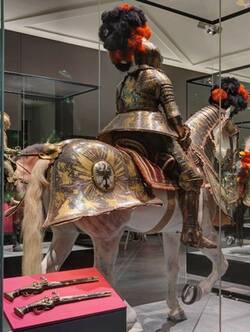This blued armour painted with gold for horse and rider was the last of its kind to find a place in the Dresden Armoury. Once again it was a Christmas present. In 1622, Magdalena Sibylla gave her husband, Elector Johann Georg I, this princely gift, which also included a regimental baton, a saddle and the bridle you see here, and “. . . a pair of pistols, . . . with the Elector’s coat of arms on the back, in a red velvet holster . . .”
The Elector had received a splendid Libaerts armour as a wedding present from his brother, Christian. Sadly, the Elector’s bride, Sibylla Elisabeth von Württemberg, died after giving birth to their first child. Almost twenty years later, Johann Georg received the armour you see here from his second wife. By now, ceremonial armour of this kind was going out of fashion, but it may be that the Elector had long coveted the even more magnificent Hercules Armour that his brother had once purchased for himself, a matching suit of armour for a knight and his charger. Johann Georg had nothing of this kind until his second wife presented him with this one.
This later armour was made by Hieronymus Ringler and embodies all the knowledge and skill of European craftsmen. It is fitted, for instance, with numerous articulated tassets to ensure maximum freedom of movement. But it was no match for thundering canons or the firearms of modern warfare depicted in the gold-painted decorations. And the painting itself, as spirited and detailed as it is, is merely an echo of the etching and chasing of earlier ceremonial armours.
The two wheel-lock pistols, which were also part of that Christmas present in 1622, bear the coat of arms on the oval butt caps mentioned in the inventory. It’s the full coat of arms of the Electors of Saxony around 1620, painted in gold on the iron fittings. The rapier also dates from the early seventeenth century.
